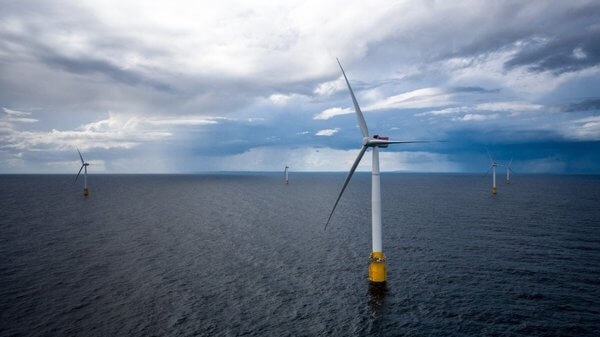News Release from windfair.net
Wind Industry Profile of
Setback for Japanese Offshore Wind Efforts
Floating Offshore Wind
The waters around Japan are dropping steeply just off the coast. As a result, unlike the UK, the country has hardly been able to benefit from its island position in the offshore wind energy sector. For conventional turbines, the seabed is simply too deep, so the only possibility is floating turbines.
This technology has taken an enormous step forward in recent years. Off the coast of Scotland, the world's first floating wind farm, Hywind by Equinor (formerly Statoil), has been producing electricity for several months. There are also initial projects in Southern Europe and off South Korea, although not yet on a commercial level, but as test facilities.

Hywind off the coast of Scotland is a complete success so far (Image: Equinor)
Japan is looking for alternatives
After the nuclear catastrophe of Fukushima, a rethinking has begun in Japan. Until then, the country had relied almost exclusively on fossil energy and nuclear power and had hardly invested in renewable energies. Things have been different since 2011. After initially even a gradual phase-out of nuclear power was decided, the government under Prime Minister Abe has since reversed it, but at least decided to reduce the share of nuclear power in the energy mix. In addition, a promotion system for renewable energy based on the German model was introduced to promote the construction of wind farms and solar plants. However, the mountainous terrain in many places does not make this work easy. So it's only natural to dodge into the sea.
Since then, various consortia have built test facilities for floating offshore wind turbines off the Japanese coast with Fukushima region in focus. The region was supposed to be supplied with offshore wind, but these efforts have now suffered a severe setback, as Japanese newspaper The Asahi Shimbun reports.

The 7 MW floater, built here three years ago, is since causing problems (Image: Fukushima Offshore Wind Consortium)
Test systems don't reach hoped-for yield
Supported by the Ministry of Economy, Trade and Industry, three floating offshore wind turbines with an output of 2, 5 and 7 megawatts and a transformer station were built since 2011 20 kilometers off Naraha for 58.5 billion yen (527 million dollars) by a consortium of the Marubeni Corp., Mitsubishi Heavy Industries Ltd. and other companies.
Now it has turned out, however, that the plants are producing much less electricity than initially anticipated. While the capacity factor - the ratio of actual to maximum possible output - for new wind turbines should be around 30 percent, only one of the three turbines has actually reached this value: the 2MW turbine even achieved a slightly higher result of 34 percent in the past two years. The 5MW turbine, which was commissioned in February last year, only managed 12 percent, the 7MW turbine just 2 percent.
The ministry blames various technical defects including the gearbox for that, but announced that "the results of the trial should be examined first of all" before making a decision on the efficiency of the turbines.
Other projects are not initially affected by a possible ending of the project, the government emphasized though.
- Author:
- Katrin Radtke
- Email:
- press@windfar.net
- Keywords:
- wind turbine, floater, Japan, coast, capacity factor, yield, turbine, lower



























